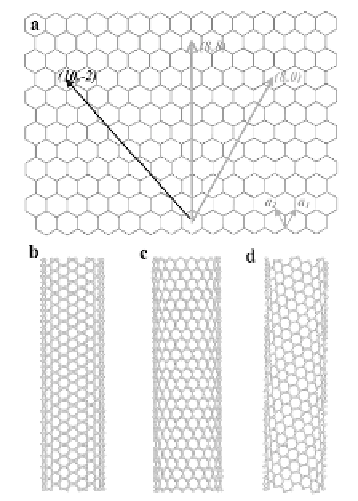Biomedical Engineering Reference
In-Depth Information
The structures of the described nanotubes for armchair, zigzag,
and chiral tubes are shown in Fig. 9.3 [35]. The value of (
)
determines the chirality of the nanotube and affects the optical,
mechanical, thermal, and electronic properties. In particular,
nanotubes with
n, m
|
n
-
m
|
= 3
q
are metallic and those with |
n
-
m
|
±
= 3
is an integer). From a statistical
point of view, one-third of the possible nanotubes conformations
are metallic whereas the remaining two-thirds are semiconducting.
Only armchair CNTs with
q
1 are semiconducting (
q
are strictly metallic tubes due to
their special symmetry. The band gap of semiconducting SWCNTs
is inversely proportional to the diameter and corresponds to 0.8 eV
for a tube with a diameter of 1 nm. SWCNTs with diameters up to
5 nm and as small as 0.4 nm have been observed, but the diameter is
typically between 0.7 and 2 nm, providing band gaps in a range that
is interesting for transistor and diode applications [25].
n = m
(a)
(b)
(c)
(d)
Figure 9.3
(a) Schematic honeycomb structure of a graphene sheet.
SWCNTs can be formed by folding the sheet along lattice
vectors. The two basis vectors
are shown. Folding
of the (8, 8), (8, 0), and (10, -2) vectors lead to (b) armchair,
(c) zigzag, and (d) chiral tubes, respectively. This figure is
reprinted with permission from ACS [35].
a
and
a
1
2







